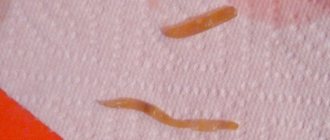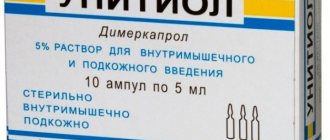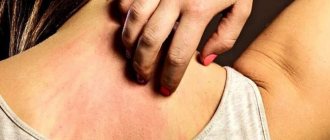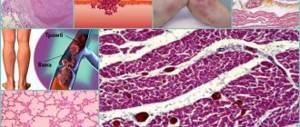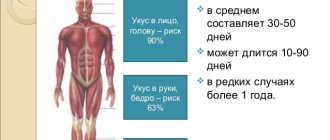Symptoms
Microsporia is characterized by pronounced symptoms. The initial stage of pathology on smooth skin is characterized by the presence of a raised spot and swelling. The disease is characterized by a small number of foci.
, hair fragility is observed on the scalp . The disease has general symptoms:
- Weakness;
- Fatigue;
- Nervousness.
The lesions may itch . Some patients report a burning sensation . The symptoms of the disease directly depend on how long it is treated and whether therapy is carried out at all.
The suppurative form of the disease is characterized by the formation of soft nodes that have a bluish-red color. The occurrence of this form of the pathological process is observed with irrational therapy.
Lesions can be distinguished from healthy skin. After the incubation period has passed, the patient will experience peeling of the skin , as well as the appearance of a pink-gray tint . Places affected by the pathological process are displayed as black dots . During the period when the disease acquires a suppurative form, blisters appear on the affected areas of the skin.
If the patient experiences the first symptoms of the disease, he needs to seek help from a doctor who will prescribe effective treatment.
Principles of treatment of microsporia
For single lesions, the child receives treatment at home; for multiple lesions and/or the development of a purulent process, the child receives treatment in a hospital setting.
Antifungal drugs are prescribed for oral administration: Grisiofulvin, Itraconazole, Terbinafine (Lamisil).
Locally, the lesions and adjacent areas of the skin are treated with products containing antifungal substances:
• Cyclopiroxolamine: Batrafen, Cyclopirox olamine, Dafnedzhin, Cyclopirox, Sebiprox.
• Terbifin: Lamisil, Binafin, Thermikon.
The products are used in the form of a gel, lotion, solution, spray or ointment.
Before applying antifungal drugs, the lesions are treated with iodine solution.
For topical use, other agents are prescribed that have antifungal properties and the ability to cleanse the skin of dead cells (crusts): sulfur, sulfur-tar or sulfur-salicylic ointments.
The duration of treatment is from 4 to 8 weeks, sometimes longer if there is no positive effect.
Vitamins, agents to protect the liver and improve blood circulation are added to the basic treatment.
Differences from trichophytosis
Quite often microsporia is confused with trichophetia. But these diseases are characterized by the presence of certain distinctive features. With microsporia, a person's hair breaks off and short shafts remain , and with trichophytosis they fall out almost at the lesion.
The first disease is transmitted from people , and the second - from animals. Microsporia can go away on its own in adolescence. For trichophytosis, it is necessary to prescribe treatment, since in its absence complications may develop.
Sources and routes of infection
Like any other fungus, microsporia is very contagious, that is, contagious. Animals, especially homeless ones, are more often susceptible to it. They release the fungus into the external environment along with the hair affected by it. But humans are not immune from the danger of contracting microsporia from a sick animal. This is why it is so dangerous to pick up or pet stray animals, because fungus is easier to prevent than to cure.
From the moment of infection with microsporia from a sick animal until its first clinical manifestations appear on the body, 5 to 7 days pass. But you can also become infected from a person who already has microsporia. In this case, you will notice its manifestations no earlier than 28-40 days.
Photo
Microsporia has pronounced signs, which makes it possible for even an inexperienced person to identify it. Symptoms of the pathological condition are clearly expressed in the photo.
How do you get infected with fungus?
The causative agent of mycosis is widespread in nature, so infection occurs everywhere. The disease is more often diagnosed in people living in countries with humid and hot climates. Infection occurs through contact and household contact when:
- using items contaminated with spores,
- touching a carrier of infection - an animal or a person.
Conventionally, all pathogens of microsporia are divided into 3 types:
- Anthropophilic - parasitic in the human body. Infection is possible through tactile contact or kissing.
- Geophilic - live in the ground. The infection is transmitted by eating unwashed vegetables, fruits, and contaminated water.
- Zoophilic - affects animals. Dogs and cats are most often carriers of the fungus.
Contact of parasites on human skin is not enough to cause infection. During normal functioning of the immune system, the causative agent of microsporia is destroyed. The entrance gates for mycotic infection are damage to the skin - abrasions, burns, cuts, ulcers.
Mycologists identify a number of factors that provoke microsporia:
- non-compliance with sanitary and hygienic rules,
- increased sweating of hands,
- regular contact with animals or soil,
- vitamin and mineral deficiency.
The risk group includes people suffering from systemic or indolent diseases - lupus erythematosus, tonsillitis, pyelonephritis.
Depending on the pathogen, the incubation period of microsporia lasts 1-6 weeks.
Treatment in adults and children
In most cases, in children the disease is treated using supportive therapy , since upon reaching adolescence it most often goes away on its own. Adult patients are recommended to be prescribed appropriate treatment, which consists of the use of antifungal drugs. Most often, patients are treated using:
- Terbinafine;
- Clotrimazole;
- Ciclopirox;
- Isoconazole.
If the localization of the disease is the scalp, then its treatment should be carried out with Terbinafine and Griseovulfine. To ensure the fastest and most effective treatment of the disease, it is necessary to ensure that crusts do not form . For this purpose, the use of special dressings is recommended. To carry out the procedure, you must use salicylic petroleum jelly. Vegetable or olive oil is used to treat lesions.
In order to reduce the inflammatory process, sprays, ointments and gels are used, which are developed on the basis of glucocorticosteroids.
Tavocort, which belongs to the category of combination drugs, is quite effective If a secondary infection occurs during the course of the pathological process, this requires the prescription of antibiotics and antiseptics.
If microsporia of smooth skin affects vellus hair or the disease occurs on the scalp, then the affected areas must be shaved.
Preventive measures
Treatment of microsporia in humans can sometimes take a long time, so it is better to remember about prevention. If hygiene and sanitary standards are not observed, the infection will quickly spread, and this is fraught with the development of an inflammatory process. One should take into account the fact that there is no vaccine against microsporia , which means that it is important to isolate a sick person during treatment, otherwise relatives and friends will become infected.
- In any children's groups it is necessary to carefully examine children regularly.
- It is worth periodically disinfecting various household items where fungal spores could persist.
- You should not pet other people's animals.
- It is important to periodically take your pets to the veterinarian in order to recognize the disease in time or ensure its absence.
Microsporia does not pose a significant threat , but it is uncomfortable and can be aggravated by a bacterial infection. To avoid this, treatment based on the use of antifungal and antiseptic drugs should be started. After treatment, it is worth thinking about prevention.
Microsporia in humans
Prevention
The main preventive method of a pathological process is the timeliness of its detection.
In this case, the patient must be isolated and given effective therapy. The patient's personal belongings must be processed. For this purpose, the use of special disinfectant solutions is recommended. If a person has been diagnosed with microsporia, then it is necessary to conduct an examination of people who have been in close contact with him . If there is a suspicion of ringworm in animals, it is recommended to show them to a veterinarian. After each contact with pets, you must wash your hands. This is because they can carry fungal diseases in the absence of corresponding symptoms.
Microsporia is a complex disease that has corresponding symptoms. When they appear, the patient should immediately consult a doctor, which will ensure the success of treatment. The treatment regimen should be developed only by a doctor.
What you can do on your own
If one of your relatives becomes ill with microsporia, then a number of measures should be taken. First you need to protect the rest of your household from possible infection. The patient needs to be given a separate set of clothes and linen, which are then put into a bag specially designated for this. Such items should be washed at the highest temperature with the addition of a 1% Chloramine solution.
In the room where the patient is constantly located, you should regularly do wet cleaning, and then boil all used rags. If lichen affects the scalp, then you must wear a bandage, which is burned after recovery. Compliance with these rules will help avoid infection with microsporia, even if someone close to you already suffers from this disease.
Diagnosis of fungus
Microsporia is diagnosed and treated by a dermatologist. To identify the causes of skin lesions, the following are prescribed:
- Luminescent study. The essence of the procedure is to illuminate the epidermis and hair with a Wood lamp. In ultraviolet light, mold takes on a bright green hue. Based on the examination data, the causative agent of the disease and the area of the lesions are determined.
- Microscopic analysis. To confirm the fungal nature of the skin inflammation, tissue samples from the affected areas are examined. Under a microscope, fungal spores and mycelial filaments are revealed.
- Cultural research. A highly accurate analysis is used to determine the type of fungus. Based on the results of the analysis, the sensitivity of the microbe to antimycotics – antifungal agents – is assessed.

